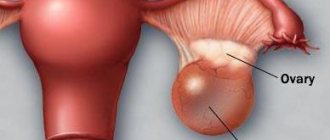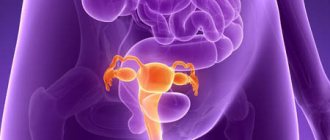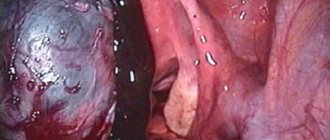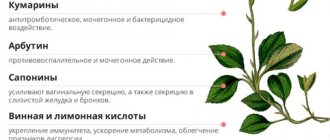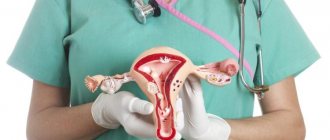Is it possible to cure an ovarian cyst without surgery?
In a significant number of cases, the cyst resolves without surgery. As a rule, already during the next menstruation the presence of a cystic formation in the ovary is not noted. Many small cysts can be cured using conservative methods without surgery.
However, if the cavity formation in the ovary reaches enormous sizes, conservative methods of getting rid of it alone will not be enough. To avoid rupture and bleeding, you should visit a doctor and get rid of the cyst surgically.
Pain when breaking
The sensations accompanying the rupture of education should be considered separately. A follicular cyst, the rupture of which occurred in the middle of ovulation, may not bother you. After a dermoid formation ruptures, a woman may fall into a state of shock, the pain is so severe.
Regardless of the type of cyst, the pain after the rupture occurs in the lower abdomen. Gradually spreads higher, lower back pain may occur. The factor leading to such consequences is often sexual intercourse performed in a harsh form, intense physical activity, or trauma to the pelvic organs. Making attempts to change position and move, the woman feels an increasing attack of pain.
Until the moment of rupture, pain appears, covering the pelvic part, sacrum, and lower back. Many people do not pay attention, stopping the attack. The duration of pain after rupture causes tachycardia, a sharp decrease in blood pressure, loss of consciousness, and shock.
Do pills for cysts help and do they contribute to recovery?
There is no single method of treatment. Each case requires serious consultation and examination, so it is impossible to know whether a particular remedy can cure the disease.
Drug treatment is used only if the cystic formation behaves benignly and does not progress to a malignant stage. In these cases, the doctor decides whether surgery is needed or whether continuing conservative therapy can be done.
Urgent surgery is recommended if high rates of tumor growth are detected.
Anti-inflammatory treatment
Anti-inflammatory drugs are acceptable for the development of acute pain syndrome. If there are stomach diseases, the doctor decides whether they can be taken or whether they need to be replaced with others. The following medications are recommended:
- Paracetamol;
- Ibuprofen;
- Nurofen.
The use of Acetylsalicylic acid is prohibited, because it irritates the gastric mucosa.
Hormonal treatment
For cysts, progesterone derivatives are used. Using tests, the doctor determines whether such medications can be prescribed to a woman and in what dose. Progesterone regulates the normal course of the second half of the menstrual cycle. Taking medications with progesterone analogues reduces the size of the cyst. The most effective hormonal drug is Duphaston, or Utrozhestan.
Contraceptives are used as medications. They suppress the release of estrogen, which results in no menstruation. Consequently, the cyst also stops growing. Doctors recommend drinking Anteovin, Janine.
Causes
The cyst may appear during pregnancy
Despite the high level of development of the medical industry, even to this day the reasons that can lead to the formation of ovarian cysts are not reliably known. However, there are a large number of provoking factors, almost all of them are associated with hormonal imbalance. These include:
- disruption of the functioning of the endocrine system;
- period of bearing a child;
- menstrual irregularities;
- the patient has a history of surgical interventions on organs located in the pelvis;
- gynecological diseases of an inflammatory nature.
It is necessary to emphasize that the listed pathological conditions and processes do not 100% cause the formation of a cyst, but only increase the risk of its formation.
The cyst can be localized at the site of the corpus luteum or at the location of a follicle that has not burst. As a result of the fact that the follicle does not rupture, an increase in the size of the bladder is observed, as a result of which a follicular cyst of the appendage is formed.
It is important to determine the cause of the formation of the cyst, because this will greatly facilitate its treatment.
Traditional methods of treatment
If a cyst is detected, you should not despair and worry about whether you need to have surgery. With the help of traditional methods of treatment, it is possible to achieve stable regression of the tumor and even its resorption. Successful treatment of the disease is carried out only with the knowledge of the gynecologist.
Special compositions for tampons
They are laid overnight. There are such recipes.
- Honey with mumiyo. To prepare the composition, you need to take 3 g of resin, dissolve it in water and add a little candied honey to it. A tampon is soaked in the mixture and inserted into the vagina.
- Soak tampons with nettle juice and insert them into the vagina for the whole night.
- Soak gauze swabs with aloe juice and insert them into the vagina for 10 days.
Decoctions and infusions
For cysts, take the following infusions and decoctions.
- Burdock decoction. To prepare it, take fresh leaves of this plant and boil for 15 minutes. The product should be taken orally, 2 - 3 tbsp. for 3 weeks.
- To prepare a decoction of dandelion roots, take 1 tsp. finely chopped dandelion root, pour 1 cup of boiling water. Leave for half an hour. Take 50 ml twice a day.
Douching
The following products are used for douching.
- Infusion of the cuff. To prepare it, 3 tbsp. herbs are poured into 0.5 liters of natural red wine. There is no need to bring the wine to a boil during heating. Apply 2 times a day.
- Infusion of celandine. 10 g of fresh herb is poured into a glass of boiling water and left for 24 hours. After this, the infusion can be taken for the procedure.
Tampons with onion and honey
To prepare such a tampon, you need to place a large onion in a hot oven for about 15 minutes. Then it should be dipped in honey and left for several hours. The bulb should be wrapped in gauze and inserted into the vagina at night for 10 days.
Tampons with Kalanchoe and honey
Mix a small amount of plant juice with honey, soak a tampon in it and insert it into the vagina overnight. The number of such procedures is 10. It is not recommended to take too much juice, as this can injure the mucous membrane.
Hog queen
You need to take 1 tbsp. herbs, pour a glass of boiling water over it, place the whole mixture in a jar. Take 3 tbsp orally. up to 5 times a day.
Red brush
To prepare the tincture, take 3 tbsp. plants, pour four glasses of vodka or alcohol into it. This medicine needs to be infused for 2 weeks in a dark place. Drink 1 tsp. three times a day before meals.
Diagnostics
If the size is significant, the doctor can detect the formation during a routine bimanual examination on the gynecological chair; if the cyst reaches gigantic proportions, then it can even be felt through the anterior wall of the abdomen.
Smaller tumors are best diagnosed with routine ultrasound. This method allows you to evaluate the exact size, structure and expected nature of the formation.
The doctor also conducts a Doppler examination of the vessels feeding the cyst. Additional instrumental methods are computed magnetic resonance imaging.
These studies may be prescribed if the location is atypical or difficult to visualize on ultrasound.
From laboratory tests, it is necessary to determine the tumor markers CA-125 and HE4. They help indirectly assess the benign nature of the tumor.
Possible consequences
A disregard for your health, established rules and restrictions is fraught with the development of the following dangerous complications:
- Violation of the integrity of the tumor cavity with the outpouring of secretory fluid into nearby organs. This phenomenon ends in severe inflammatory processes and unpleasant symptoms,
- Inability to conceive, bear and give birth to a healthy baby,
- Early menopause
- Oncological diseases affecting the reproductive organs,
- Deterioration in the functioning of nearby vital organs due to increased exposure to the tumor,
- The occurrence of adhesive disease.
The most dangerous consequence of inappropriate treatment is death.
FAQ
When choosing a treatment method, patients ask the gynecologist the following questions:
Is it always necessary to remove an ovarian cyst?
No, not all formations are subject to mandatory surgical treatment. Functional cysts can even spontaneously regress without surgery. Endometriosis often goes away with the onset of menopause.
Do I need to remove an ovarian cyst if it does not bother me and is not growing?
It all depends on the type of education. If we are talking about functional cysts, dynamic observation is sufficient. If a dermoid or paraovarian cyst is detected, surgery is inevitable, but it can be postponed for some time. It is better to remove serous formations immediately after diagnosis, as the risk of malignancy is high.
When is a cyst on the ovary cut out, and when is the entire organ removed?
The extent of the operation depends on the size of the lesion, location, age of the woman and other factors.
How dangerous is surgery for ovarian cysts?
Laparoscopic intervention is tolerated quite well. After the operation and recovery from anesthesia, short-term weakness, pain in the lower abdomen, and headache are noted. Recovery after laparoscopy takes 12-14 days. The menstrual cycle returns to normal within a month. You can plan a pregnancy 3-6 months after endoscopic removal of the formation. Proper selection of anesthesia and compliance with safety precautions can reduce the risk of possible complications.
After laparoscopic surgery, a woman recovers quickly because this treatment method is minimally invasive.
Can menopause occur after removal of an ovarian cyst?
In most cases, the operation goes well and menstrual function is not affected. It happens that when trying to remove a cyst or perform an ovarian resection, healthy tissue containing follicles is injured. A decrease in the supply of follicles can lead to an early onset of menopause and the appearance of its characteristic symptoms: hot flashes, emotional lability, decreased libido, etc.
How much does it cost to remove a left/right ovarian cyst?
The price is determined by the volume of the operation and the selected access. The average cost of laparoscopic cystectomy in Moscow clinics is 25-30 thousand rubles. According to the compulsory medical insurance policy, the operation is performed free of charge for the patient.
Nutrition
The diet of any person affects his health. The food we consume daily greatly affects the amount of hormonal elements in the body. Proper and balanced nutrition helps stabilize a woman’s hormonal levels and, accordingly, helps to quickly cure a dangerous pathology.
For cystic tumors in the uterine appendages, it is necessary to exclude from your diet foods and supplements that accelerate the process of blood outflow. These include:
- Smoked, dried products,
- Spicy dishes and sauces,
- Sweets,
- Excessively salty foods
- Spices,
- Canned vegetables, fish, etc.
It is recommended to eat more fresh vegetables and fruits, lean meat, and dairy products - they enrich the body with beneficial microelements and stimulate the proper functioning of the immune system.
Recommendations
For a rapid recovery and restoration of normal life activities, medical specialists make the following recommendations:
- During therapeutic measures, you should follow all the instructions of the attending physician,
- One should not turn a blind eye to existing contraindications for cystic neoplasms,
- It is necessary to listen to every signal from your body: if you experience discomfort during any usual procedures, it is better to stop and reschedule classes for a more favorable time,
- After favorable results and complete recovery from benign cysts, the girl is recommended to visit the gynecological office twice a year for a preventive examination.
Complications
Any operation has its own risks and complications. Despite the more gentle technique, during laparoscopy injuries to neighboring organs are possible; the trocar is inserted into the abdominal area blindly and there is always a minimal risk of injury to large blood vessels.
Laparotomy has an order of magnitude greater number of complications. In addition to those mentioned above, there are risks of unsuccessful hemostasis and the occurrence of postoperative bleeding and adhesions.

